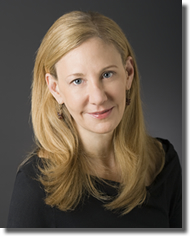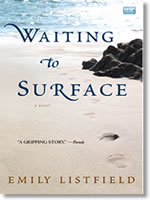Toronto, Ontario
Canada
EMILY LISTFIELD‘s novel Waiting to Surface (2007) is a fictional rendering of real-life events surrounding the mysterious disappearance of her sculptor husband in 1999. Emily is a former magazine editor-in-chief and author of five novels. Her writing has appeared in The New York Times, Harper’s Bazaar, Redbook, Self, Ladies’ Home Journal, New York magazine, and Parade. She lives in New York City with her daughter.
AL: Waiting to Surface is based on your experiences prior to and following your husband’s sudden disappearance—an unfolding of events so heartbreaking that most of us, until we’ve read your book, couldn’t begin to imagine living through them. It seems to me a brave thing to relive this through writing. Did it feel brave to you at the time? Does it now?
EL: It didn’t feel particularly brave then (nor does it now)—it felt necessary. Writing has always been my way of making sense of the world. If you are a writer, and something like this happens to you, it seems unavoidable that eventually you will end up using writing to come to terms with the experience.
AL: How long after his disappearance did you decide to tackle the book? Was there a particular incident or realization that sparked the drive to write it?
EL: I always knew I would have to write about it. In fact, I was incapable of writing anything else until I got this book out of the way—but it took years. First I tried writing the book as a memoir, but I had already published a number of novels and I am most comfortable in the world of fiction. It was also too soon—perhaps a year after events—and I didn’t have the distance necessary. The writing I did then belonged in a journal, not in a bookstore. But when I was ready to write Waiting to Surface, those early starts helped to inform the final draft.
AL: What did the novel form offer you that memoir wouldn’t?
EL: I wanted to be able to shape experience, to condense events, and to create composite characters, so a novel was the right choice for me.
AL: Had you kept a journal or notes as things unfolded? Or did you write mostly from memory?
EL: It was a combination. I kept a journal on and off. Sometimes things were happening too fast or were too painful for me to write down. But it is not the kind of thing you forget. I also had correspondence from police, detectives and the Coast Guard.
AL: How closely did you follow the facts of what happened? That is, is it a novel loosely based on fact, or a memoir thinly veiled as fiction?
EL: Virtually everything in the novel happened in real life, but as I said, the timeline is condensed and the characters are composites in some cases. For example, it took me years to get a divorce, and seven years to get a death certificate for my husband, but all those things happen much sooner in Waiting to Surface. Some things I made up for dramatic effect, though: I did not actually go to Florida.
AL: How close is your character to that of Sarah?
EL: She’s younger and blonder!
AL: Did it require a great deal of self-examination and self-awareness to bring her character, and her emotions and reactions, to life on the page? What did you learn about yourself?
EL: I think this was the most beneficial part of writing the book. It made me truly examine the past, my marriage and my feelings. It helped me to appreciate all that was good in my husband and how difficult his struggles were. It also helped me think about the notion of uncertainty, and how coming to terms with it is one of the central tenets of all of our lives.
AL: Did you begin with an outline, or did you write more randomly to bring to life memorable scenes from that time?
EL: Well, I knew the story—and I knew the ending, or lack of ending—so the flow didn’t surprise me. I had the last scene written in my head all along.
AL: I can only imagine what an emotional undertaking it would be to write a book like this. Were there times when you doubted that you could manage it? How did you push through those doubts?
EL: There were times, which is why I wrote the whole book first before showing it to anyone (my agent or editor). I wanted to make sure I could finish it. I kept going because it felt necessary to me that I write it.
AL: Were there family members or friends or colleagues whose opinions you worried about as you wrote certain scenes? How did you deal with this? Did you show the manuscript to anyone before publication?
EL: I was only worried about my daughter. She was six when this occurred and thirteen when the book was done. She read it last year when she was fifteen—she wasn’t ready before that. I was prepared for many more questions than she actually asked. I think that she will absorb it in different ways as she gets older. I have been careful to explain that this is my narrative and that everyone has a right to create his/her own—including my daughter. Anyway, she said she liked it—which is a simple reply but all I can really ask for.
AL: What were the reactions of people close to you?
EL: Well, it was painful for friends and family to read because it was a difficult time for them, too, and it brought that all up. Many said it gave them a greater understanding of what I went through at the time.
AL: One of the greatest challenges must have been to write in a balanced way about your husband when you had so many questions about his behaviour and his feelings prior to the disappearance. But you write of him with compassion. Did you have to work at this?
EL: The writing helped me discover the compassion. It helped me realize the pain he must have been in. That took a while as I was so angry in the immediate aftermath, and hurt and confused, but writing helped me realize his interior world—as well as what a tragedy it was for all of us.
AL: What scenes did you find most painful to write?
EL: I’ll answer that in reverse: The magazine and dating scenes were a relief to write!
AL: All writing involves a selection process, choosing what to keep in and what to leave out. Aside from the obvious—the need to craft a compelling story—what other factors informed these choices?
EL: I did not want to write anything that would hurt people I care about.
AL: Several years later, if you had the chance would you write the book differently? If so, how?
EL: I don’t really think it’s a good idea for writers to second-guess themselves. I’d probably write everything I ever wrote differently—but you do the best with what you have available at the moment.
AL: What advice do you have for those embarking on writing about a difficult experience?
EL: Make sure you have given yourself enough time and distance to truly shape the experience.
AL: This line from the book has stayed with me: “But [Sarah] would learn to live in a world without certainty.” How has having faced uncertainty in the way you did influenced how you live your life now?
EL: Uncertainty is a fact in all of our lives. There is no guarantee when you say goodbye to someone in the morning that you will see that person again. It’s one of the central struggles. This will sound hopelessly cliché but I have truly learned to appreciate each moment, especially those with my daughter. Of course things get to me, but I try to keep them in perspective. The more I, or any of us, can live in the present, the better. I think you need to come to terms with the past to be able to move on. When you resolve internal conflict you can put it aside and concentrate on the present.
For more about Emily Listfield, visit her blog, Brunch Babble.
Copyright 2010 Allyson Latta.

